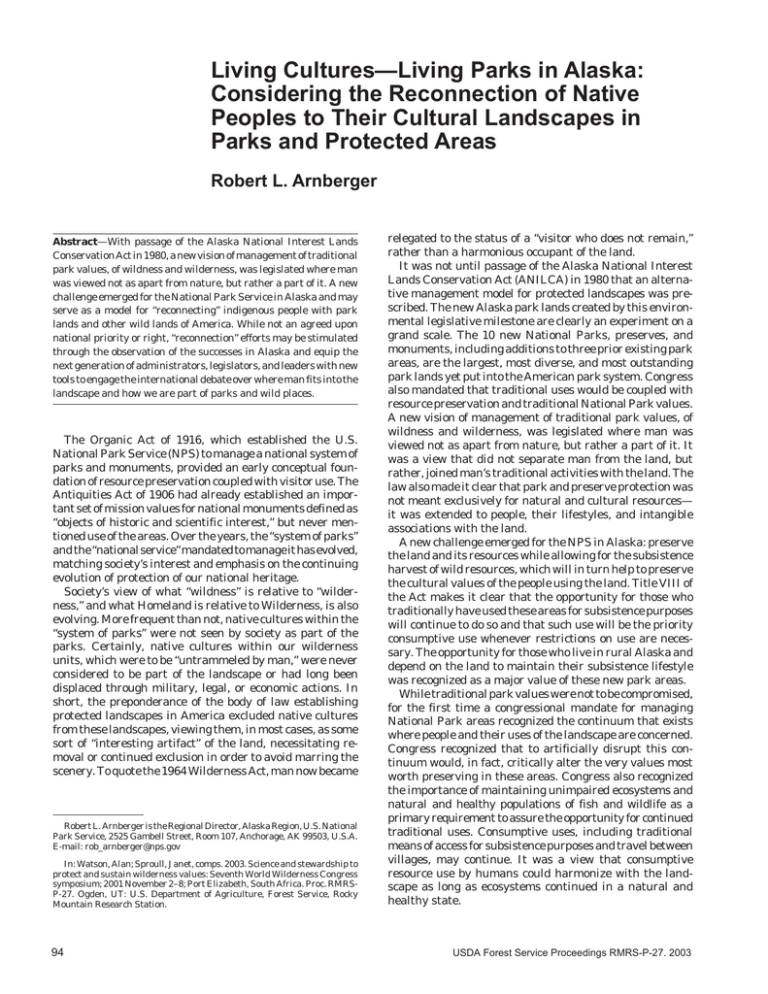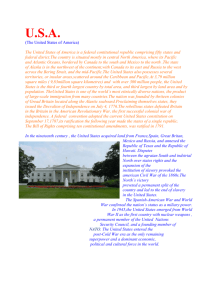Living Cultures—Living Parks in Alaska: Considering the Reconnection of Native
advertisement

Living Cultures—Living Parks in Alaska: Considering the Reconnection of Native Peoples to Their Cultural Landscapes in Parks and Protected Areas Robert L. Arnberger Abstract—With passage of the Alaska National Interest Lands Conservation Act in 1980, a new vision of management of traditional park values, of wildness and wilderness, was legislated where man was viewed not as apart from nature, but rather a part of it. A new challenge emerged for the National Park Service in Alaska and may serve as a model for “reconnecting” indigenous people with park lands and other wild lands of America. While not an agreed upon national priority or right, “reconnection” efforts may be stimulated through the observation of the successes in Alaska and equip the next generation of administrators, legislators, and leaders with new tools to engage the international debate over where man fits into the landscape and how we are part of parks and wild places. The Organic Act of 1916, which established the U.S. National Park Service (NPS) to manage a national system of parks and monuments, provided an early conceptual foundation of resource preservation coupled with visitor use. The Antiquities Act of 1906 had already established an important set of mission values for national monuments defined as “objects of historic and scientific interest,” but never mentioned use of the areas. Over the years, the “system of parks” and the “national service” mandated to manage it has evolved, matching society’s interest and emphasis on the continuing evolution of protection of our national heritage. Society’s view of what “wildness” is relative to “wilderness,” and what Homeland is relative to Wilderness, is also evolving. More frequent than not, native cultures within the “system of parks” were not seen by society as part of the parks. Certainly, native cultures within our wilderness units, which were to be “untrammeled by man,” were never considered to be part of the landscape or had long been displaced through military, legal, or economic actions. In short, the preponderance of the body of law establishing protected landscapes in America excluded native cultures from these landscapes, viewing them, in most cases, as some sort of “interesting artifact” of the land, necessitating removal or continued exclusion in order to avoid marring the scenery. To quote the 1964 Wilderness Act, man now became Robert L. Arnberger is the Regional Director, Alaska Region, U.S. National Park Service, 2525 Gambell Street, Room 107, Anchorage, AK 99503, U.S.A. E-mail: rob_arnberger@nps.gov In: Watson, Alan; Sproull, Janet, comps. 2003. Science and stewardship to protect and sustain wilderness values: Seventh World Wilderness Congress symposium; 2001 November 2–8; Port Elizabeth, South Africa. Proc. RMRSP-27. Ogden, UT: U.S. Department of Agriculture, Forest Service, Rocky Mountain Research Station. 94 relegated to the status of a “visitor who does not remain,” rather than a harmonious occupant of the land. It was not until passage of the Alaska National Interest Lands Conservation Act (ANILCA) in 1980 that an alternative management model for protected landscapes was prescribed. The new Alaska park lands created by this environmental legislative milestone are clearly an experiment on a grand scale. The 10 new National Parks, preserves, and monuments, including additions to three prior existing park areas, are the largest, most diverse, and most outstanding park lands yet put into the American park system. Congress also mandated that traditional uses would be coupled with resource preservation and traditional National Park values. A new vision of management of traditional park values, of wildness and wilderness, was legislated where man was viewed not as apart from nature, but rather a part of it. It was a view that did not separate man from the land, but rather, joined man’s traditional activities with the land. The law also made it clear that park and preserve protection was not meant exclusively for natural and cultural resources— it was extended to people, their lifestyles, and intangible associations with the land. A new challenge emerged for the NPS in Alaska: preserve the land and its resources while allowing for the subsistence harvest of wild resources, which will in turn help to preserve the cultural values of the people using the land. Title VIII of the Act makes it clear that the opportunity for those who traditionally have used these areas for subsistence purposes will continue to do so and that such use will be the priority consumptive use whenever restrictions on use are necessary. The opportunity for those who live in rural Alaska and depend on the land to maintain their subsistence lifestyle was recognized as a major value of these new park areas. While traditional park values were not to be compromised, for the first time a congressional mandate for managing National Park areas recognized the continuum that exists where people and their uses of the landscape are concerned. Congress recognized that to artificially disrupt this continuum would, in fact, critically alter the very values most worth preserving in these areas. Congress also recognized the importance of maintaining unimpaired ecosystems and natural and healthy populations of fish and wildlife as a primary requirement to assure the opportunity for continued traditional uses. Consumptive uses, including traditional means of access for subsistence purposes and travel between villages, may continue. It was a view that consumptive resource use by humans could harmonize with the landscape as long as ecosystems continued in a natural and healthy state. USDA Forest Service Proceedings RMRS-P-27. 2003 Arnberger Living Cultures—Living Parks in Alaska: Considering the Reconnection of Native Peoples… Importantly, the Act did not distinguish between native indigenous peoples and other rural peoples. However, rural demographics in many areas are almost exclusively native Alaskan peoples. How does this “great experiment” in Alaska serve as a model for “reconnecting” indigenous people with park lands and other wild lands of America? While most Alaska Natives, by luck or an accident of history, were never forcibly evicted as they were elsewhere, indigenous peoples, by most measures, are not afforded this connection to most park landscapes in the rest of the country. Their “reconnection” is certainly not an agreed upon national priority or right. The historical record is generally one of eviction and culture devaluation, rather than one of connection and valuation. The public debate can be polarized and intense, promising no easy answers. This is an issue fraught with political, economic, social, and legal challenges. The NPS finds itself placed squarely in the middle of a complex social debate. It will present land managers with some of the most important emerging land management issues of the future. Is the collection of eaglets in Wupatki National Monument by the Hopi Indians for religious purposes problematic? When the Mickosuki Indians create and improve a settlement in Everglades National Park, are there contentious issues? When the Timbisha in Death Valley National Park demanded the return of a homeland within the park, did they threaten traditional park values? When the Hualapai of the Grand Canyon asserted jurisdiction over NPS lands within Grand Canyon National Park, did it challenge administrators? Did each of these examples create complex legal and policy challenges? Yes, of course they did, including challenging the capacity of NPS administrators to find constructive resolution approaches because of an extremely limited “toolbox” of law and policy alternatives. Because of these challenges, do we refuse to engage potential solutions and deny cultural connections to homelands that existed before parks were established, or cultural practices that predate modern man? Do we relegate “living cultures” to the junk pile of “extinct cultures” because we choose not to engage the issue and look for possible resolutions? No, of course not—nor is anyone proposing that. Do we exercise care and deliberation, understanding each case, each people, each issue, and understanding that each resolution (if there is one) may be similar but always different? The affirmative answers are self-evident because these peoples already stand upon our doorstep, knocking on the door of many of our National Parks across the nation, demanding back something they have lost. While the record is still evolving, it is clear that the Alaskan experiment establishes a precedent for study and comparison. Alaskans are assured of continued legal, cultural, and subsistence connections to the landscape. Our USDA Forest Service Proceedings RMRS-P-27. 2002 national conversation about man in wilderness and native homeland versus untrammeled Wilderness has been broadened and deepened. That is why ANILCA holds so much promise. Alaska is serving as a laboratory of how indigenous peoples and their cultures remain and are joined with the landscape—inseparable from it. They are a deeply held and important component of what parks and wild places are. They are not just a collateral value. In fact, the culture joined with the land is one and the same value. This model will be needed as the NPS struggles throughout our park system, engaging native peoples and their “reconnection” to the landscapes protected in these units, but frequently lost as traditional cultural landscapes. Just as America presented the world with the first Wilderness Act in 1964, perhaps ANILCA can help redefine all peoples’ relationship with the land throughout America and perhaps the rest of the world. It may be that the Alaska model equips the next generation of administrators, legislators, and leaders with new tools to engage the international debate over where man fits into the landscape and how they are part of parks and wild places. It may be that the wisdom legislated in Alaska, and the generational struggle to make the law work, will mature a society to honor the fact that man has always been part of the land. Because we evolved from the land, the land has always been with man. He has carried it with him during the long march through time. The land is not only in his DNA, but also in his heart and his spirit. If man is to succeed in this endeavor of living on the land, then he cannot be separated from it. Additional Sources ______________ Alaska National Interest Lands Conservation Act. 1980. PL 96-487. 16 USC: 3101–3233. American Indian Religious Freedom Act (AIRFA). 42 USC 19961996a. PL 95-341, 103-344. Antiquities Act. 1906. 16 USC 431–433. June 8, 1906, ch. 3060, 34 Stat. 225. Arnberger, Robert. 2001. Living cultures: living parks. Issue paper presented to the National Park System Advisory Board, March 2001. Brown, Bill. 2001. Overview of subsistence in Alaska. Issue paper presented to the George Wright Society, April 19, 2001. National Park Service Organic Act. 16 USC 1-4; August 25, 1916, ch. 408,39 Stat. 535. National Park System General Authorities Act. 16 USC 1a-1 et seq, PL 91-383, 94-458, 95-250. National Park System Advisory Board Report 2001. Rethinking the st National Parks for the 21 century. July 2001. Shaver, C. Mack. [n.d.]. Traditional National Park values and living cultural parks: seemingly conflicting management demands coexisting in Alaska’s new National Parkland. George Wright Society Journal. Wilderness Act 1964. 16 USC 1131-1136. PL 88-577. 95 3. Wilderness: Systems and Approaches to Protection Viewing wildlife in the Shamwari Game Reserve (photo by Alan Watson). 97







